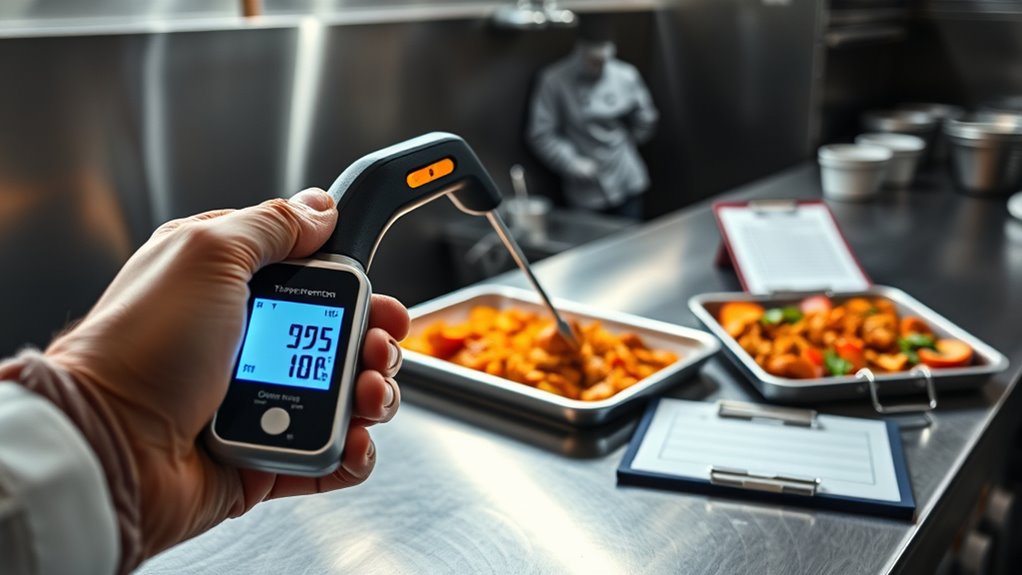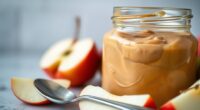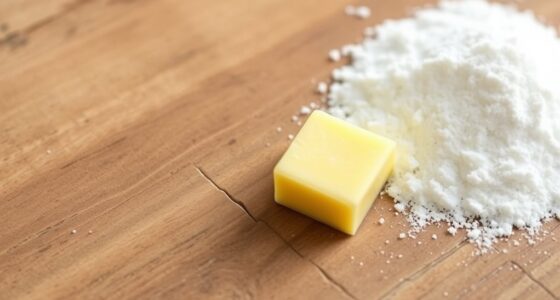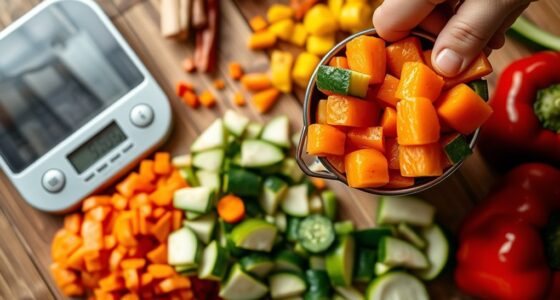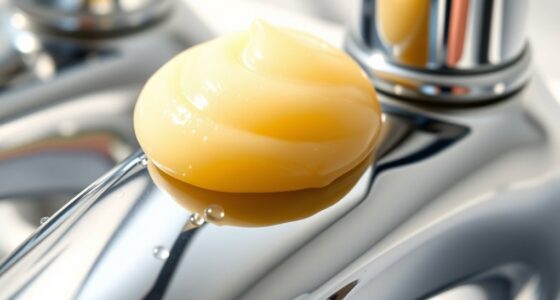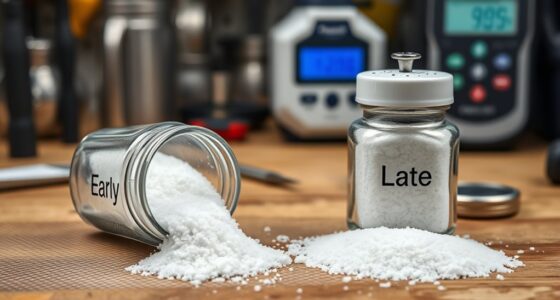To troubleshoot food safety temperatures quickly, start by calibrating your thermometers to verify accuracy with ice water or boiling tests. Check your refrigerator and freezer temperatures and adjust thermostats if needed. Measure the internal temperature of cooked foods with properly calibrated probe thermometers, ensuring they hit safe levels. Look for common issues like equipment malfunction or hot spots and fix them promptly. Keep your system in check—learn more for effective, ongoing temperature control.
Key Takeaways
- Verify calibration of thermometers using ice water or boiling water reference points.
- Regularly check storage temperatures and adjust thermostats if readings are outside safe ranges.
- Test cooked food temperatures with food safety certified probe thermometers immediately after cooking.
- Inspect equipment for malfunctions or hot spots that may cause temperature fluctuations.
- Ensure staff follow proper procedures and document all temperature checks and calibration activities.
Gather and Calibrate Your Thermometers

To guarantee accurate temperature readings, you need to gather reliable thermometers and calibrate them regularly. Start by understanding the different thermometer types, such as digital, dial, and infrared, to choose the right tools for your needs. Once you have your thermometers, follow proper calibration procedures to assure accuracy. For digital and dial thermometers, calibration often involves adjusting the device with known reference points, like ice water or boiling water. Infrared thermometers require proper emissivity settings and calibration against a known surface. Regular calibration prevents errors that could compromise food safety. Keep a log of calibration dates and procedures. Properly calibrated thermometers help you monitor temperatures precisely, reducing the risk of unsafe food handling and ensuring compliance with safety standards. Additionally, understanding food safety temperatures is crucial to maintaining proper cooking and storage practices.
Check Storage Temperatures of Refrigerators and Freezers
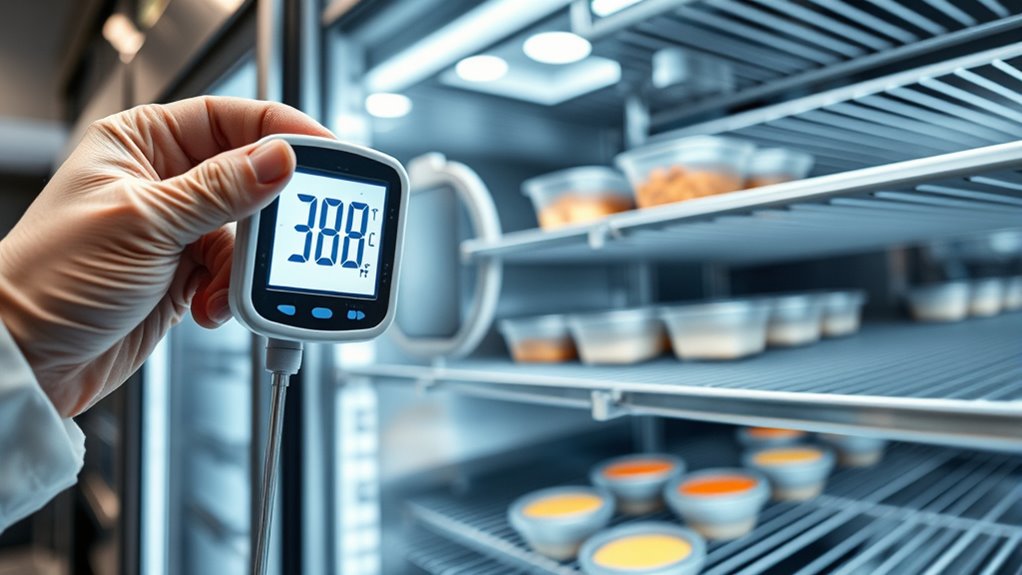
Ensuring your refrigerators and freezers maintain proper temperatures is essential for food safety. Start by performing regular temperature monitoring with a reliable thermometer to verify storage units are at the correct range—35°F to 38°F for refrigerators and 0°F for freezers. Use calibration techniques to confirm your thermometers provide accurate readings; this might involve ice water tests or comparing against a known standard. Check the temperature regularly, especially after power outages or door openings. If temperatures are off, adjust the thermostat settings and recalibrate your thermometer if needed. Maintaining consistent, accurate readings helps prevent food spoilage and bacterial growth. Properly calibrated thermometers and diligent temperature monitoring are key to keeping your food safe and compliant with health standards. Additionally, understanding the role of contrast ratio can help ensure your equipment displays accurate temperature readings for optimal food safety management.
Test the Internal Temperatures of Cooked Foods
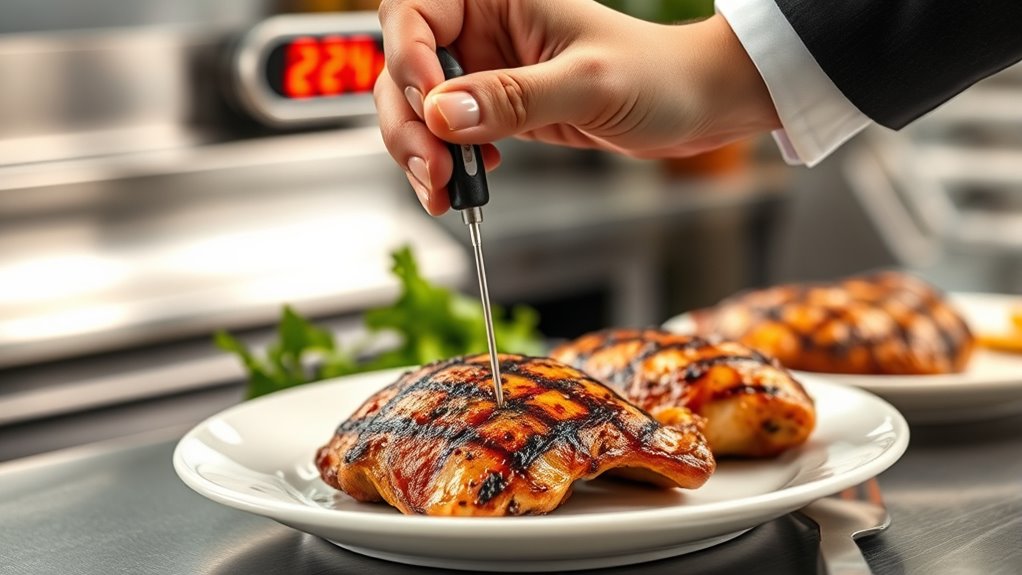
Are you confident that your cooked foods reach safe internal temperatures? Using reliable temperature monitoring devices is essential for food safety certification and ensuring proper cooking. To verify, insert a calibrated probe thermometer into the thickest part of the food, avoiding bones and fat. Record the temperature and compare it to recommended safe levels:
| Food Type | Minimum Internal Temperature | Time Required |
|---|---|---|
| Poultry | 165°F (74°C) | Immediately after cooking |
| Ground Meat | 160°F (71°C) | Immediately after cooking |
| Seafood | 145°F (63°C) | Immediately after cooking |
Regular testing helps prevent foodborne illnesses and guarantees compliance with safety standards. Make sure your devices are accurate and have proper food safety certification for reliable results. Additionally, using calibrated thermometers ensures your readings are precise and trustworthy.
Identify and Address Common Temperature Fluctuation Causes
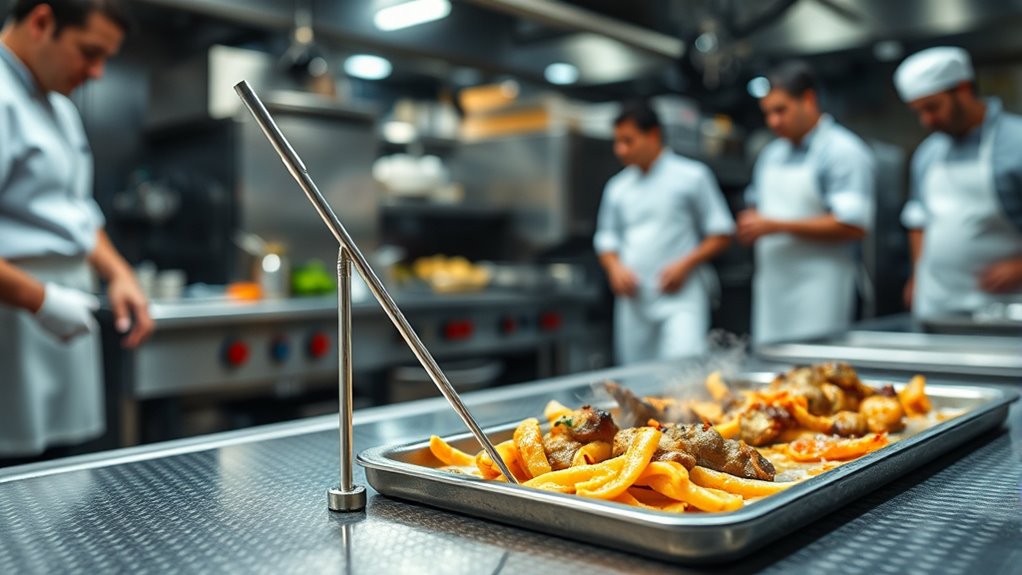
Temperature fluctuations during cooking or holding can occur due to several common factors, potentially compromising food safety. One major cause is equipment malfunction, such as faulty thermostats or broken heating elements, which can lead to inconsistent temperatures. Additionally, cross contamination risks increase if proper separation isn’t maintained, allowing bacteria to spread and cause temperature irregularities. Overloading refrigerators or warm areas around heat sources can also cause hot or cold spots, making it harder to sustain safe temperatures. Regularly inspecting and maintaining equipment ensures it operates correctly, reducing fluctuations. Keep an eye out for signs of malfunction and address issues immediately. Proper equipment maintenance is essential to prevent temperature issues and ensure food safety. By understanding these common causes, you can quickly identify problems and take action to maintain consistent, safe food temperatures.
Implement Preventative Measures to Maintain Consistent Temperatures
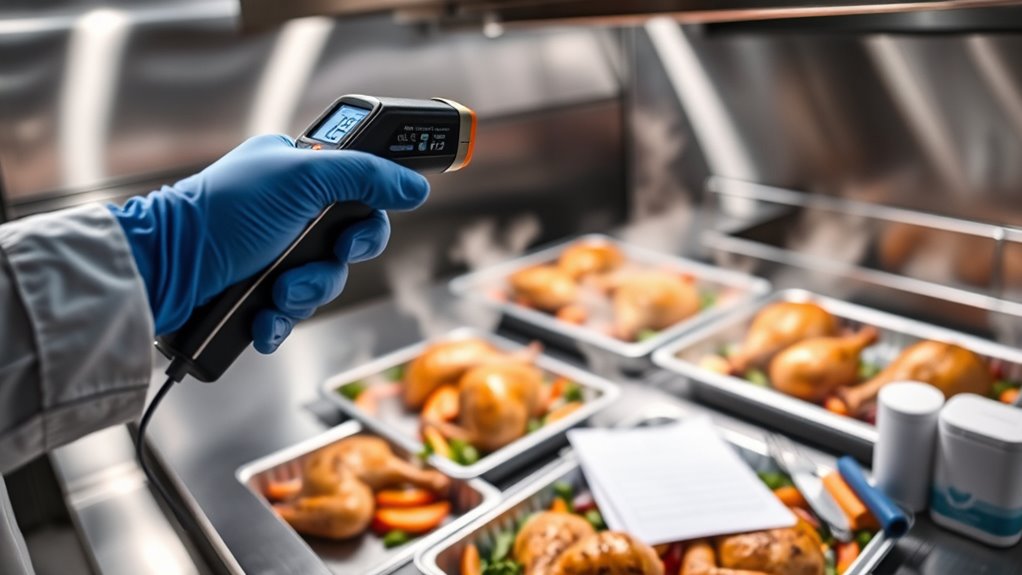
To maintain consistent temperatures and prevent food safety issues, implementing proactive measures is essential. Start by establishing strict proper cleaning routines for all equipment and storage areas. Regular cleaning prevents buildup that can interfere with temperature regulation and reduces contamination risks. Additionally, invest in thorough staff training to ensure everyone understands temperature control procedures, such as calibration and monitoring. Educate your team to recognize signs of temperature fluctuations and respond immediately. Keep detailed records of cleaning schedules and temperature checks to identify patterns that could cause inconsistencies. Incorporating temperature monitoring devices can further enhance accuracy and reliability. By combining diligent cleaning with well-trained staff, you create a reliable system that maintains safe temperatures consistently, reducing the risk of foodborne illnesses and ensuring compliance with safety standards.
Frequently Asked Questions
How Often Should Food Safety Thermometers Be Replaced?
You should replace your food safety thermometers when calibration accuracy declines or the battery life diminishes substantially. Regularly check calibration to ensure precise readings, and change batteries promptly to maintain reliability. Typically, replace thermometers annually or as needed based on usage and performance. Keeping an eye on these factors guarantees accurate temperature measurements, helping you uphold food safety standards efficiently and avoid potential contamination risks.
What Are the Signs of a Malfunctioning Thermometer?
You’ll notice a malfunctioning thermometer if it gives inconsistent readings or if calibration issues arise. If it’s not showing accurate temperatures, it might need recalibration or replacement. Check the battery lifespan, too; a dying battery can cause inaccurate readings or unresponsiveness. Regularly testing your thermometer against a known standard helps identify these signs early, ensuring you maintain proper food safety temperatures and avoid potential health risks.
Can Different Types of Thermometers Be Used Interchangeably?
You can’t always use different types of thermometers interchangeably because calibration varies. Digital thermometers are quick and easy to read, while analog ones might need more careful calibration to guarantee accuracy. Always check if your thermometer is calibrated properly before switching between digital and analog devices. Keep in mind that each type has its own maintenance needs, so don’t assume they’re interchangeable without verifying accuracy first.
How Do Ambient Room Temperatures Affect Food Temperature Readings?
Think of ambient room temperature as a background artist subtly influencing your thermometer readings. If the room is too warm or cold, it can skew your thermometer’s accuracy, making your food seem hotter or colder than it truly is. To troubleshoot effectively, always check your thermometer’s calibration and verify it’s used in a stable room environment. This way, your temperature readings stay reliable, safeguarding food safety.
What Is the Best Way to Sanitize Thermometers Between Uses?
You should sanitize thermometers between uses by following proper cleaning protocols. First, use a damp cloth with mild detergent to remove any residue, then disinfect with alcohol wipes or a sanitizing solution. Regularly check calibration techniques to guarantee accurate readings. This process prevents cross-contamination and maintains food safety. Always allow the thermometer to air dry thoroughly before next use for ideal accuracy and hygiene.
Conclusion
By keeping your thermometers sharp and your storage temperatures steady, you’re the captain steering a ship through safe waters. Regular checks and quick fixes act like sturdy anchors, preventing dangerous temperature swings. With these simple steps, you’re not just troubleshooting—you’re orchestrating a symphony of safety, ensuring every bite stays fresh and every meal is a masterpiece. Stay vigilant, and let your food safety efforts shine brighter than a lighthouse guiding the way.
